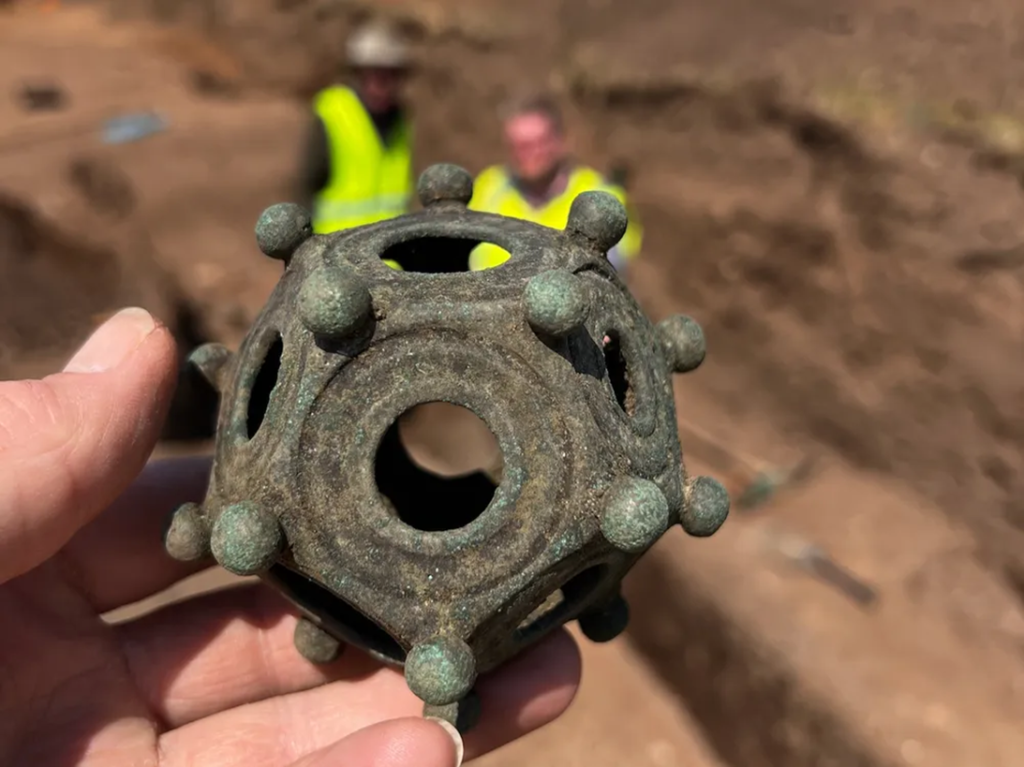
The Norton Disney, Lincolnshire, UK dodecahedron as found in a trench dug by an archaeological group of local volunteers. (Image credit: Norton Disney History and Archaeology Group)
“There is nothing more exciting than solving a mystery.” — Agatha Christie
“Everything must be taken into account. If the fact will not fit the hypothesis—let the hypothesis go.” — Agatha Christie, “The Mysterious Affair at Styles”
“…when you have eliminated the impossible, whatever remains, however improbable, must be the truth” — Conan Doyle, “Sherlock Holmes – The Sign of the Four”
By John Bamford
The discovery of ancient Roman dodecahedrons poses a mystery: there’s no record of what these objects were used for.
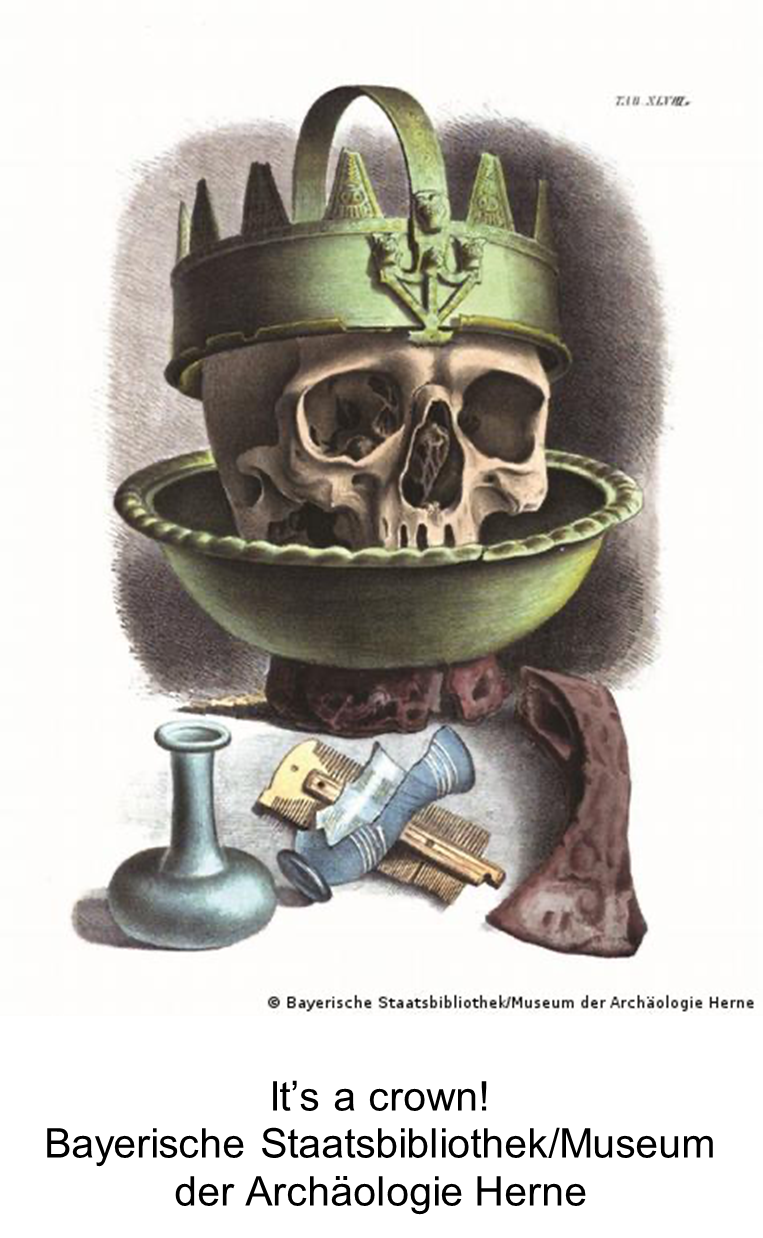
We love a mystery. Small mysteries and large. Could be a “whodunit” or a “whatsdat”. The challenge of a puzzle, and the reward that comes from of solving it with the satisfaction of revealing the unknown, of uncovering the hidden or giving meaning to the mysterious.
Along the way, there are the potential twists and turns, when new information emerges that can challenge former conclusions. Paradigms are disputed by contradictory evidence, revealing entirely new ways of viewing the mystery.
And sometimes we get it badly wrong.
In the 1995 post-apocalyptic film Waterworld, objects unknown for centuries after the end of civilization – a yo-yo, an exercise machine, and a flute – are mistakenly identified as a garrotte, a torture device, and a spy listener.
In “The Awakening”, the first episode of the 1980s television series Buck Rogers in the 25th Century in which an astronaut from the 20th century is marooned in the 25th century, the guide at a 25th century museum tells visitors that a 20th century hair dryer is probably an early hand laser.
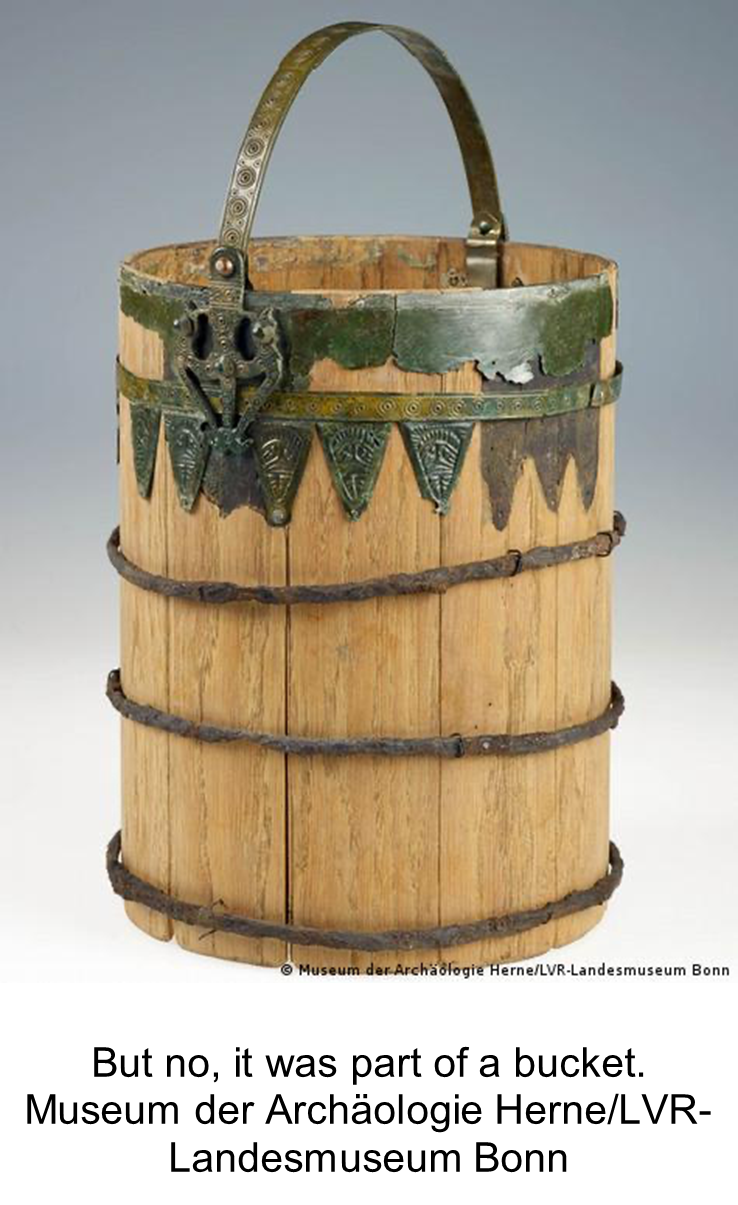 But “that’s just in the movies.” Or maybe not.
But “that’s just in the movies.” Or maybe not.
In 2019 at the Roemer and Pelizaeus Museum in Hildesheim, Germany, in an exhibition titled “Fake & Facts — Wrong Tracks in Archaeology,” a round piece of iron with decorative fittings and a loop including copper alloy was initially identified as a crown. It was later determined to be the fitting from a 6th century AD bucket.
So sleuths beware!
The Mystery Begins
 In 1739 a local historian in Aston, Hertfordshire, England discovered what appeared to be an ancient regular dodecahedron-shaped, hollow object made of bronze. It was found in an area that was once a Roman settlement at the crossing of two roads. This was the first known discovery, at least in modern times, of what is now called a Roman (or Gallo-Roman) Dodecahedron.
In 1739 a local historian in Aston, Hertfordshire, England discovered what appeared to be an ancient regular dodecahedron-shaped, hollow object made of bronze. It was found in an area that was once a Roman settlement at the crossing of two roads. This was the first known discovery, at least in modern times, of what is now called a Roman (or Gallo-Roman) Dodecahedron.
Most recently, in 2023, in the village of Norton Disney in Lincolnshire, UK, a volunteer with the Norton Disney History and Archaeology Group discovered a well preserved dodecahedron in an area where Roman coins and broaches had previously been unearthed. This would be the 33rd similar object discovered to date in what was Roman Britain. In total, about 130 similar objects have been discovered largely across what were the north/northwest areas of the Roman Empire.
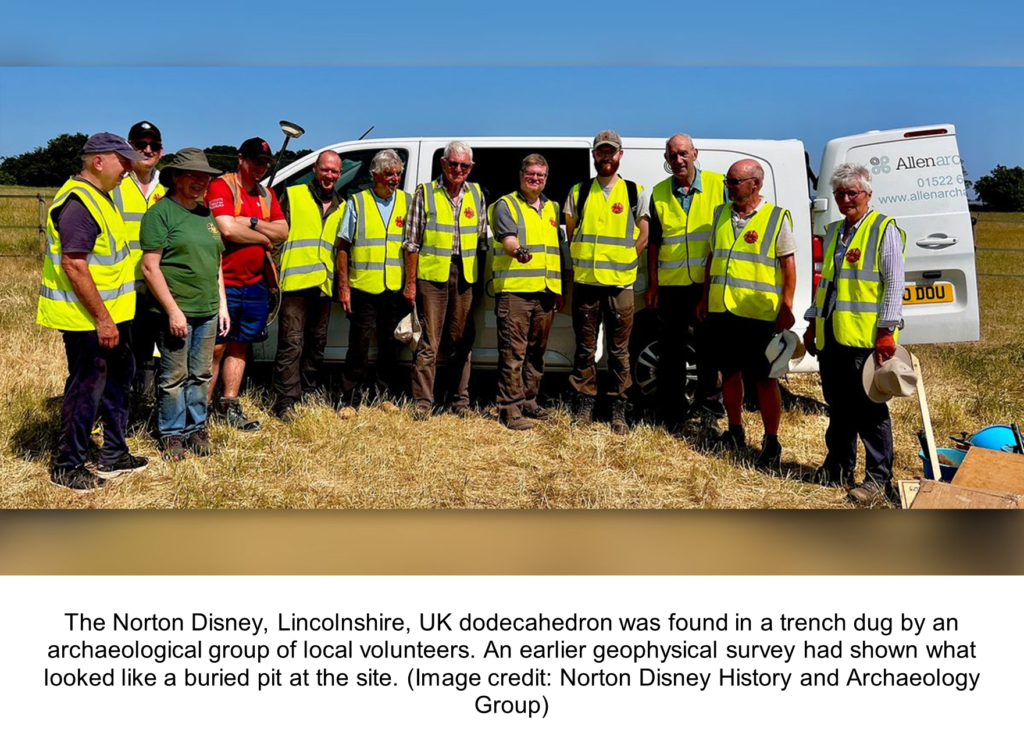
So where have they all been found?
The two maps below provide a good sense of where these dodecahedrons, in whole or in part, damaged or undamaged, have been discovered.
It’s a bit of a challenge finding a readily available detailed inventory of all the discoveries, but thanks to Michael Guggenberger here’s the link to a list he compiled (up to 2021): http://saegewerk.org/laboratory/dodekaeder-dodecahedron/
The majority of the finds were in what was Roman Britain and Gaul, areas of significant military and cultural interaction between the Gauls/Celts/Germanic peoples and the Romans. These areas include present day Austria, Switzerland, Hungary, Great Britain, Belgium, Germany, France, Luxembourg, Netherlands, Austria, Switzerland, Croatia and Hungary. The northernmost find was near Hadrian’s Wall, which cuts through Britain, and the southernmost was at Arles, France. The westernmost object turned up at Fishguard (Wales), and the easternmost at the legionary camp of Brigeto (Szőny, Hungary).
But curiously there have been no finds in what is now Italy, Spain, north Africa, or the eastern provinces of the Roman Empire, all areas with a long history of Roman occupation and influence.
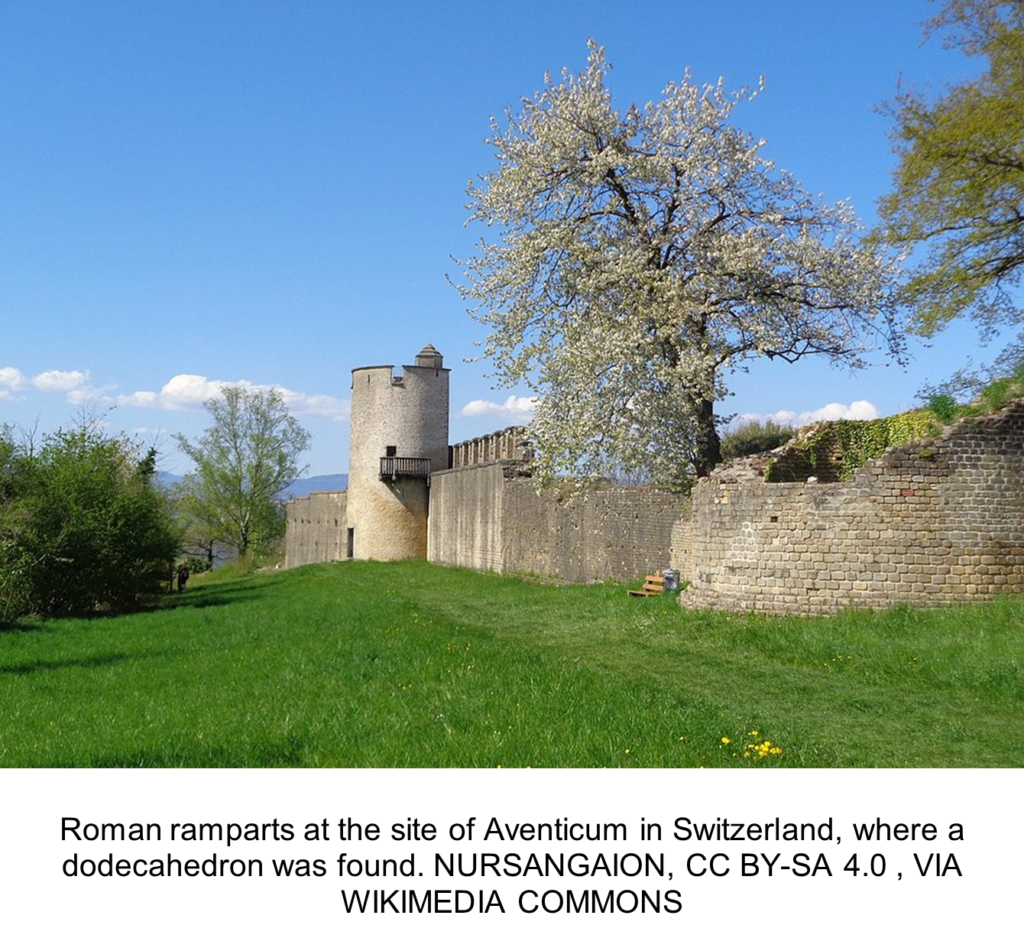 And in the Geneva area, a dodecahedron made of highly valued silver was discovered, the only known one of its kind
And in the Geneva area, a dodecahedron made of highly valued silver was discovered, the only known one of its kind
Some dodecahedrons were found in public baths, in military camps, in a theatre, in temples, in a well, and in river beds. Some were found in coin hoards and in a site that was possibly a shop selling precious metal objects, suggesting (perhaps) that they were highly valued.
Some finds were in situ (the number seems to vary, some sources say only two, others say nine), in layers of earth or with other objects or materials known to be associated with Roman occupation. Very few were found in rigorous, controlled archaeological/scientific excavations. One of the few in situ finds as part of a controlled excavation was in an expensively decorated woman’s tomb in Krefeld-Gellep, Germany. A nearby piece of bone caused speculation that it could have been some sort of handle but it’s unclear and the bone was in poor condition and not retrieved.
Others finds appear to be ex situ, disturbed by human activity or natural events. Some were found in antique stores, so identifying their provenance becomes difficult or impossible.
And since imago valet mille verba (as they said in Latin, or as we say, a picture is worth a thousand words), here are some fine examples of the many dodecahedrons found.
And just to add more to the mystery, a regular icosahedron was unearthed near Arloff in Germany in 1953. It was originally misclassified and stored with dodecahedrons, which have twelve pentagonal faces, in the Rheinisches Landesmuseum in Bonn for forty years until it was recognized as an icosahedron of twenty triangular faces!
In an article in the Mathematical Intelligencer, Vol. 18, pp. 132-133, 1996 entitled, “A Roman Icosahedron Discovered,” Benno Artmann describes the Roman icosahedron: “also hollow bronze and about 8 cm in diameter and weighing 465 grams with the distinctive knobs at each vertex of the 20 faces.” Confusingly, some sources seem to say that the icosahedron has no circular apertures; others seem to say that it has two. Looking at available photos, it does appear to have apertures. It also has quite a few concentric rings on the triangular surfaces, one larger central set of concentric rings and three smaller sets of concentric rings in each of the corners of the triangles.
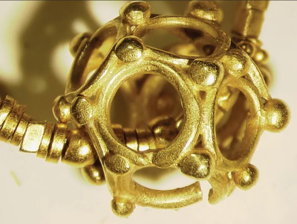
This polyhedral gold bead from Khao Sam Kaeo, in eastern peninsular Thailand, is stylistically identical to those from Óc Eo in the Mekong Delta, and to numerous similar beads from Pyu sites in Burma. (Credit: Bennett, 2009)
There’s another oddity. Dodecahedrons of similar design, but much smaller, were also found in areas of the Maritime Silk Road, a seaside area of the ancient Silk Road that connected China, Southeast Asia, India, the Arabian peninsula, Somalia, Egypt and Europe from about the 2nd century BC to the 15th century AD. Present day Óc Eo in the Mekong Delta area of Vietnam was a busy port in the Funan kingdom on the Magnus Siinus, and could be the port known as Cattigara to the Greeks and Romans.
The golden versions of these dodecahedrons are quite small and seem to be decorative jewelry beads. Or, they might have had some religious or talismanic purpose, although again, no documented purpose is known. They do look remarkably similar to the design of Roman dodecahedrons. Maybe their design originated through maritime trade interaction between southeast Asia and the Roman world. Or perhaps this was just a coincidence. According to Sherlock Holmes, however: “Coincidence? The universe is rarely so lazy.”
What is their appearance, what are they made of, and how were they made?
Each dodecahedron is a hollow metal shell with 12 faces, 20 vertices and 30 edges. Because it is regular, each dodecahedron face is an equilateral pentagon, and each face has a circular hole or aperture in the centre. The apertures vary slightly in size and appear to be graduated, the narrowest being 6 mm and the widest 40 mm, although some reports say the aperture diameters are the same in some finds.
It appears that, in most cases, ten of the twelve apertures were drilled after the dodecahedron was cast, while the other two apertures appear to have been made or used as part of the wax molding process.
The faces are often decorated with circular rings or concentric rings around the apertures that appear to be imprinted in the metal rather than carved or chiseled. Other markings include small circles with dots and lines parallel to the edges of the pentagons. None of the dodecahedrons found display letters, numbers, or characters.
Each corner or vertex where three sides meet has a semi-spherical knob or stud. When they’re intact, each dodecahedron has 20 of these knobs, one at each of the 20 vertices; the knobs can vary in size from one dodecahedron to another. The knobs appear to have been attached after the hollow metal shell was made. On the example found in London, three of these knobs appeared to be soldered to each other. Could these knobs have served as feet for stabilizing the dodecahedrons when they were set in place? Or might they have been used to hold and manipulate them? Or were they simply decorative?
The Norton Disney dodecahedron is decorated on all 12 faces. The face with the largest aperture has one concentric ring and the face with the smallest aperture has three rings. In contrast, the dodecahedron in the Gallo-Roman Museum in Tongeren, Belgium doesn’t appear to have any of these concentric rings.
The icosahedron found near Arloff apparently has apertures on only two faces opposite each other, with knobs that vary in diameter at each vertex.
The dodecahedrons range in size from about 4 to 11 centimetres, from about the size of a golf ball to about the size of a baseball. Their weight varies from about 35 to 580 grams (although one measured about 1,000 grams) based on the size of the dodecahedron and their composition. Does their variation in size suggest that size was somehow related to their use or portability?
They are usually bronze, composed of variable amounts of primarily copper (65-75%), lead (~25%), tin (~8%), zinc (~1%), and traces of iron. For example, the Norton Disney find is 75% copper, 7% tin and 18% lead, with a width of 8.6 cm and a weight of 254 grams. The dodecahedron walls are quite thin; some sources say about one to two millimetres and others say two to four millimetres. In either case, they are relatively light. Does this suggest that they were not used for some purpose that required significant strength?
Their composition is described as characteristic of a Roman type of ‘leaded gunmetal’ used to cast objects made of mixed recycled copper-alloy metal. The higher than typical lead content could be from the reuse of other metal objects, or it could be that the addition of lead increased the liquid metal’s plasticity, making it flow more easily to penetrate the spaces and corners as part of a molding process.
Trace amounts of iron could be due to surface contamination, or the iron might have been introduced in the reuse of other metal objects.
The zinc component (typically less than 2%) could be due to the reuse of other metal objects. It might also have been included in the alloy for its deoxidizing effect on liquid metal and slight hardening effect on the finished product. Also interesting is that zinc itself was less and less available in the later years of the Roman Empire, suggesting that it would have been more infrequently.
According to the Norton Disney discovery group, “A huge amount of time, energy and skill was taken to create our dodecahedron, so it was not used for mundane purposes,” and, “They are not of a standard size, so will not be measuring devices. They don’t show signs of wear, so they are not a tool.”
So, all in all, the craftsmanship, time, effort and cost of manufacturing the dodecahedrons suggests they were highly valued.
Although the metal itself cannot be accurately or reliably dated, an estimated timeframe for the manufacture of dodecahedrons found in situ has been made by association with the layers of earth where they were found, and also in relation to other objects or materials located nearby. Based on these associations, it’s been estimated that they were made between the first and fifth centuries AD.
For example, a dodecahedron was found during the excavation at the city of Noviodunum (Jublains, France) in 1995. The building in which it was found included a room and a cellar that were dated based on ceramic and coin finds to the turn of the second to third century AD. The dodecahedron was 59 mm in diameter (without the knobs), weighed 81 grams, and was made of bronze. It was also unique in that two of its opposite apertures are ellipse-shaped while all the other apertures are perfect circles varying in diameter.
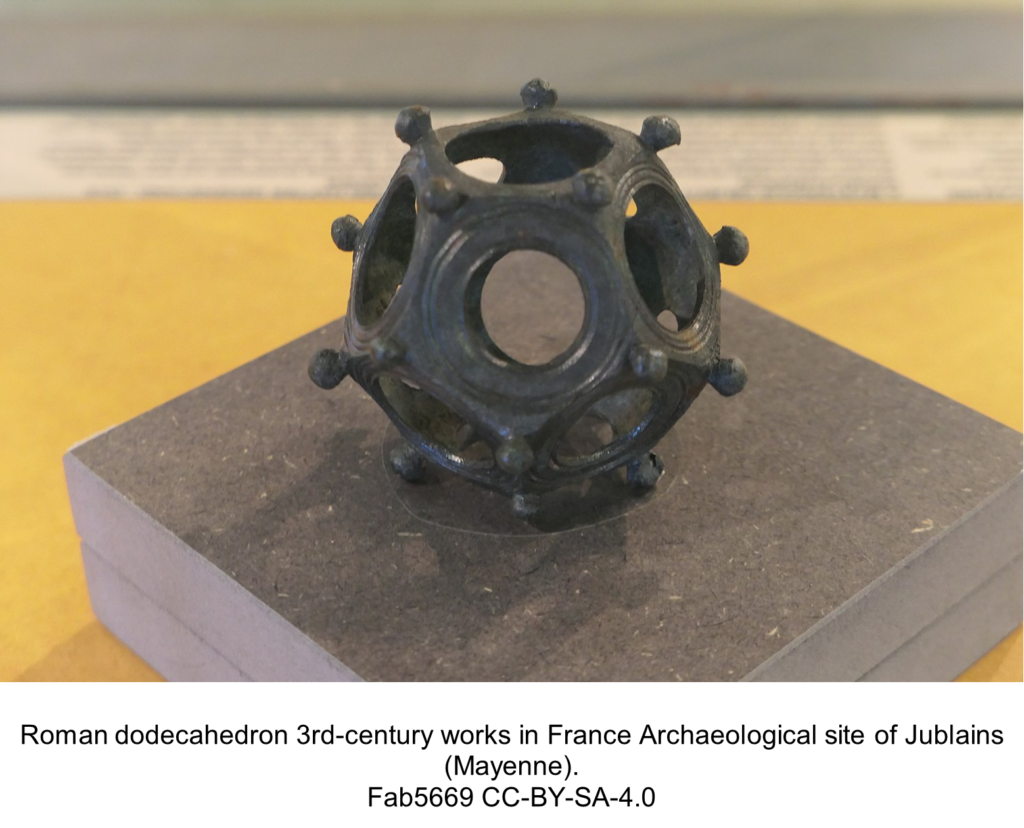
Horror Vacui: Mysteries Need a Solution
A mystery is like a vacuum that we need to fill with a solution: ideas, guesses, conjectures, and hypotheses – based on intuition, experience, knowledge, experiment, analysis, or even fantasy. Some proposed solutions seem far-fetched, some outlandish, some reasonable, and some seem compelling. We may think mysteries have been solved, only to be disappointed later. Some mysteries may never be fully solved (are some mysteries never “meant” to be solved?) And some mysteries are ultimately solved by validated theories.
An estimated 200 scientists and researchers have produced articles and papers on the topic of the Roman dodecahedrons. And there is no shortage of amateur and professional ideas, suggestions and hypotheses suggesting the dodecahedron was:
- a decoration or a luxury item
- the pommel of a sword
- a weapon or part of a weapon, a club or mace head
- a flower stand
- a candlestick holder
- the stand for a rod or staff or pole
- a holder for drinking glasses
- a calibration tool for coins
- a too for sizing finger rings
- part of a frond for sprinkling holy water
- part of a musical instrument or for sending/receiving sound
- an object used test metalworking skills
- for testing the calibre of metal of pipes
- part of a Roman military standard (insignium)
- a talisman with magic powers or for bringing good luck
- a astral-cosmic-religious symbol or cult object
- a divination device
- for hanging jewelry
- part of a field sign or direction indicator
- to hold flowers
- a tool for knitting gloves
- a rangefinder or part of theodolite
- a standard weight
- a child’s toy
- a game piece
- a type of dice
- a device for determining the optimum date for agricultural planting
- a protractor
Compounding the mystery is that there’s no mention of the dodecahedrons found in writings or drawings or sculptures or frescoes of the time. Maybe the objects were so familiar and everyday that nobody thought to mention them, although you’d think somewhere, somehow they’d get mentioned or referenced or depicted. Or maybe they were so specialized and rare that very few were familiar with them. Or might their use and meaning have been so secretive that only a few knew?
And there’s the question: does the one icosahedron discovered have any relationship to the purpose of the dodecahedrons?
Given that the list of ideas and suggestions and hypotheses is long, let’s have a look at a few that have (or did have) some potential or are just interesting.
A Candlestick Holder
Why a candlestick holder? Because wax traces (apparently yellowish in colour) were found or said to have been found inside one or more dodecahedrons. How likely is it that traces of wax would have survived for over 1600 years or more? And assuming the traces are wax, might they be the remains of their manufacturing molds rather than from a candle? Do the dodecahedrons, with their complex designs and vertices, knobs and various sized apertures (requiring considerable time, effort and skill to make), seem like something that would be made for the relatively simple task of holding a candle? As well, a candlestick holder is such a common object that you’d expect to find them widely used throughout the Roman Empire.
A Tool for Spool Knitting
Since the dodecahedrons have been found in the colder climates of northern Europe, could they have been used as tools for knitting gloves? The various apertures sizes might be used for different finger sizes of gloves, and the knobs might have been used to loop the yarn.
It’s an interesting idea, and here are a couple of innovative and very creative demonstrations of how this might have been done.
But then, as far as we know the earliest recorded use of spool knitting was in 1535 in Strasbourg. And why would knitting spools be made from something as expensive and time consuming to make as a complex bronze dodecahedron? Wouldn’t wood have been a much more practical solution, readily available and far less expensive and intricate to produce? And why would knitting spools be found in coin hoards or temples?
Then there’s the icosahedron, which doesn’t appear at all useful for spool knitting gloves.
A Dodecahedral Toy
Could the dodecahedrons “merely” be toys? Part of some sort of game?
One suggestion is that they were used in a game similar to the popular French cup-and-ball game called bilboquet, which could also be played with a stick instead of a cup. The object of the game is to swing a ball that’s attached to the cup handle or stick and get it to land in the cup or on the narrow top of the stick handle. Could a dodecahedron replace the ball in the stick version of the game? None have been found with any type of cord attached or associated, and neither have handles/sticks been found that suggest this type of use. A piece of bone found, but unable to be retrieved, in proximity to one of the dodecahedron finds seems an unlikely candidate for the stick.
There’s also a game called “knucklebones”, sometimes called jacks and by other names in different cultures. This game usually involves bouncing a ball and, while it’s still in the air, picking up more and more of the jacks or the ankle bones of sheep or whatever other types of objects are used. It’s interesting how the jacks have knobs that are kind of similar to those on the Roman dodecahedrons, but the dodecahedrons weren’t found in clusters that would have suggested they were from this type of game and their size and shape just don’t seem well suited to this use.
Or could they have been some sort of polyhedral dice, with the knobs acting as stops to bring them to rest when rolled? Wouldn’t the knobs have severely hindered them being bowled like dice?
But then if the dodecahedrons were part of a game or toy why haven’t they been found more widely spread? Why only in a particular area of the Empire? And why make and use such an intricate, expensive object like the dodecahedrons just to be used as a toy when many more common and less expensive alternatives existed?
A Test of Metalsmith Skills
Could they have been made as a test of the skills and craftsmanship of a metalsmith, perhaps to demonstrate their expert abilities to customers or as some sort of qualification for entrance into a collegium (guild)? If so, why have they only been found in a particular area of the Empire? Wouldn’t they more likely be found in significant numbers in the long-established areas of the Empire such as in Italy or Spain or Greece?
Part of a Weapon
Some 19th-century antiquarians speculated that they might be weapons, such as the head of a mace. But the dodecahedrons seem too light and their walls too thin to make them effective weapons. Similarly, their potential use as metal projectiles to be fired from slings seems again unlikely. Roman soldiers typically used solid lead balls for this purpose or even rocks or stones; why fire something so expensive and intricate to manufacture, and hollow?
Part of a Roman Military Standard
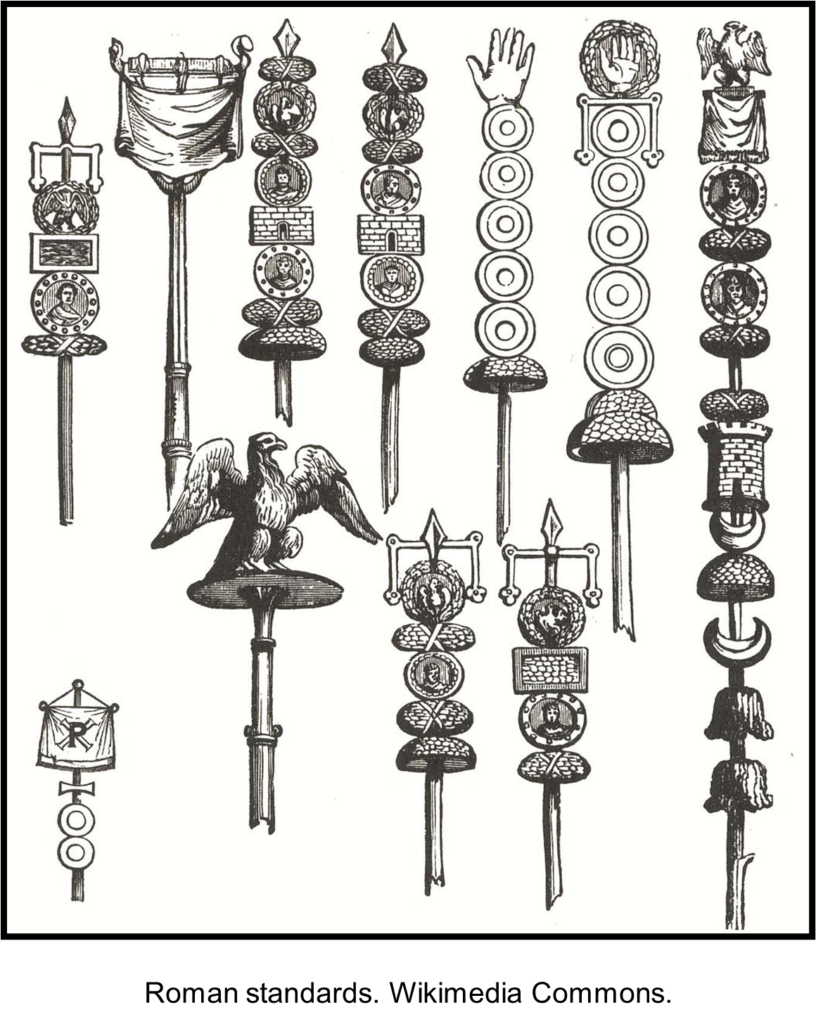
Also known as a signum militare, a signum was the military standard for a Roman century of 80 to 100 men. Signa held a variety of symbols attached to the central pole: could one of those have been a dodecahedron?
But there are no known discoveries of any Roman military-style standards/poles or associated items near the dodecahedrons. And if they were used for this purpose, wouldn’t they be found in other areas of the Empire, wherever there were Roman military activity or occupation? Or could it be that these particular objects were only associated with the Roman military presence in the areas where they have been found, maybe related to Roman interactions and campaigns in Gaul?
But then again, there have been no findings of writings or engravings or depictions of the dodecahedrons on Roman military standards.
A Sceptre Head
Similar to their possible use on a Roman military standard, could the dodecahedrons have been mounted on the tops of sceptres or rods to convey some sort of symbolic meaning? Perhaps a cosmic or mystical or magical meaning, or an insignum of authority or status of some sort, with a shaft or sceptre handle inserted into the openings? We’re told of an in situ discovery of a dodecahedron with a piece of bone nearby, but in such poor condition that it could not recovered. Might this have been some sort of handle to mount the dodecahedron on top?
But apparently no other discoveries of closely associated potential handles have so far been made. Maybe they just haven’t survived over the centuries, or maybe we have so few in situ discoveries that we have no way of knowing. Who would have used these sceptres or rods, and why only in the particular areas of the Empire where they have been found? Could these have been used by the Gauls to depict leadership or mystical or magical powers, or be related to Celtic/Druid traditions, and then captured by the Romans? Or did the Romans themselves use sceptres?
Gallo/Celtic-Roman Religious or Mystical Objects
The geographic areas where the dodecahedrons have been found were occupied and administered by the Romans and also inhabited by the Celtic peoples of Gaul. Naturally, there would have been considerable exposure to and influence from each other’s ideas, traditions, practices, and beliefs.
We also know that divination, sorcery and other magical practices were popular in Roman times prior to their suppression during the rise of Christianity, and the Celts would have been quite familiar with Druid traditions and practices. Many of the dodecahedrons were unearthed at or near burial sites. Could this imply some sort of cult, mystical, or magical practices associated with the objects based on Celtic traditions and heritage, practices that the Romans encountered and might even have adopted, adapted or exploited? And could the absence of any written or pictorial references to the objects by the Romans be due to the later suppression of their use under Christianity? Could the fragments of dodecahedrons found have been due to their intentional destruction?
Do the dodecahedron that was found at the Gallo-Roman temple near the Schwarzenacker, Germany archaeological site, and the three objects discovered in riverbeds near Trier, Nijmegen and Zürich, suggest their mystical or religious or astral-cosmic meaning and use?
According to Tibor Grüll in his article The Enigma of the Dodecahedron, “we can attribute the dodecahedra with some sort of religious function with cosmic-astral symbolism.” He further states that, “we can probably detect the continued existence ‒ or at least influence ‒ of the Gallo-Roman dodecahedra” and its twelve sides with the twelve sortes, which was the Roman term used for the practices of divination of future events contained in “the so-called Sortes Sangallenses. These have survived on a composite palimpsest manuscript datable to circa AD 600 in the library of the Abbey of Saint Gall (St. Gallen).”
He also writes that, “The twelve apertures of varying diameters probably refer to astral symbolism, but without signs and characters they cannot be unambiguously identified with celestial bodies (Sun, Moon, planets, stars).”
Inscribed on a dodecahedron made of silver lead found in Geneva in 1982, at the archaeological site around the Cathedral of Saint-Pierre, were the Latin names for the 12 signs of the zodiac. Does this suggest that it was used for divination? Do we know how it ended up in this location or where it was originally from?
As Grüll also notes, it is “also inexplicable why this form of soothsaying or divination was limited to the western half of the Roman Empire.” He also references Michael Guggenberger’s statement that “there is no evidence of any comparable [material] tradition in the Celtic world,” Including no discoveries of similar dodecahedral Celtic objects from the Iron Age and none from Roman areas prior to the 1st century AD.
Might we yet find examples of dodecahedral shaped objects or depictions or engravings in Celtic areas that were not occupied by the Romans? We know that Celtic craftsmen were skilled metalworkers in gold, iron, and bronze and in wax molding techniques. The Snettisham Great Torc dated to the 1st century BC is a spectacular example of Celtic metal craftsmanship using gold and silver including the use of wax molding. Are we certain that the dodecahedrons found to date were all made by the Romans? If they are some sort of mystical, cosmic, magical, religious or divination objects/talismans derived from Celtic/Druid traditions and practices, could some or all have been made by the Celts?
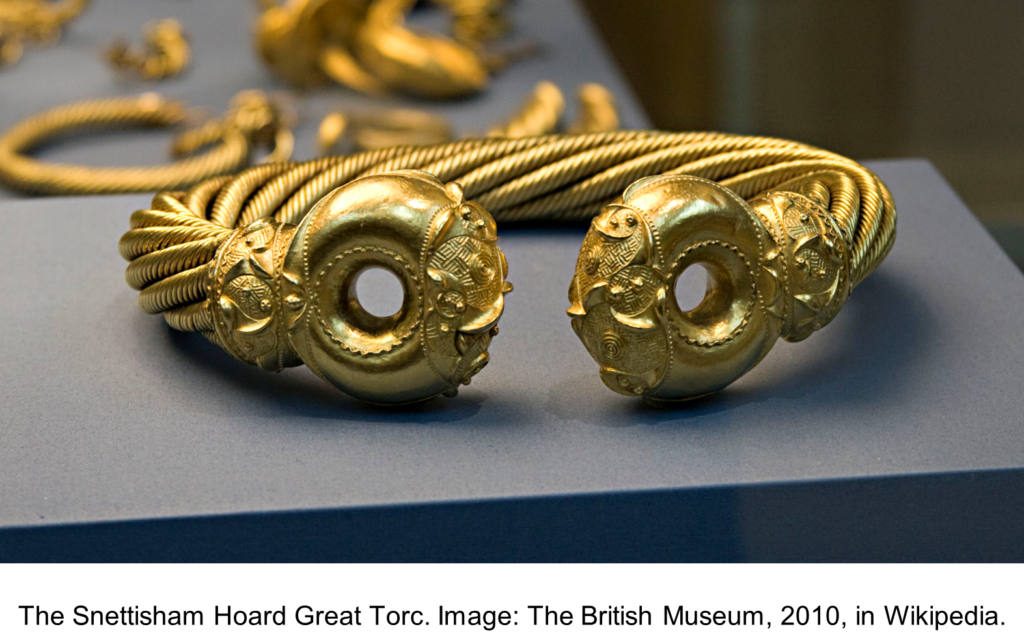
A Calibre Standardization Tool
Could the dodecahedrons have been used as caliber standardization tools, to measure and ensure the caliber of objects like water pipes or weapons or anything requiring standardized diameters? But then the apertures are not standard or consistent in size and their shape sometimes varies. The edges of the apertures also appear to be largely unused and unworn, and given the thinness of the dodecahedral walls they could be easily damaged by this type of continuous use. Wouldn’t there be simpler or more robust tools or gauges that would have been better suited to this purpose?
A Range Finder or Part of a Surveying Device (Ancient Theodolite)
In her article Roman Dodecahedron as dioptron: analysis of freely available data, Amelia Carolina Sparavigna of Politecnico di Torino concludes that the dodecahedrons are dioptrons, optical devices that could be looked through without the use of lenses for measuring angles. As dioptrons, she writes, they were used as rangefinders.
Sparavigna also quotes work by the German Amandus Weiss which proposes use of the dodecahedrons as theodolites for surveying. They could perhaps have been used with a specific tripod and a range-pole or a distant object of known height to enable the range/surveying process.
Sparavigna explains in detail the use of rangefinder equations and of measurements taken of sample dodecahedrons, their apertures openings, and the distance between apertures to demonstrate how the dodecahedrons could be used for rangefinding. This involves calculating the distance to an object of known size (such as a military standard, vexillum) by looking through pairs of differently sized apertures until the object being viewed and the edges of the two apertures are aligned. The distance calculated would be based on finding the one set of apertures lining up with the target object, noting that changing the pair of apertures used could provide better visibility of the “target” and thereby increase the accuracy of the measurements taken.
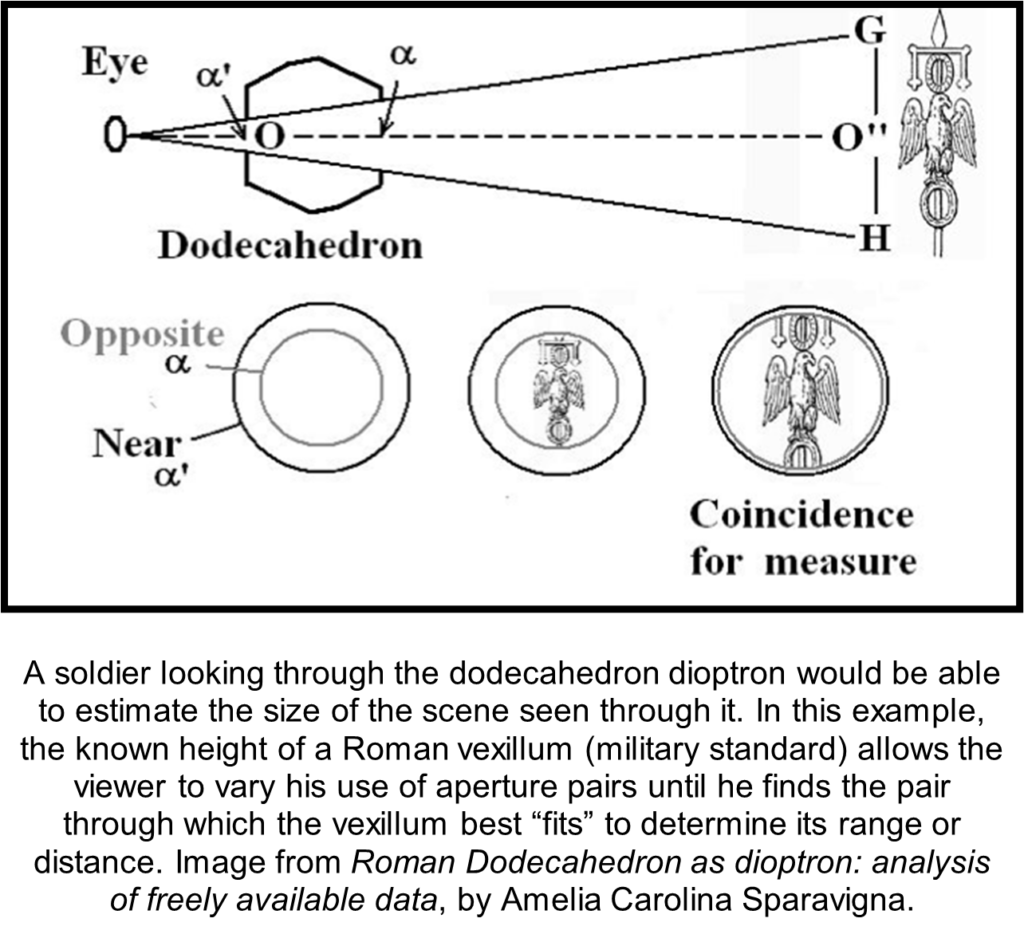
Sparavigna notes that the theodolite/surveying hypothesis seems have been first proposed “by Friedrich Kurzweil in 1957, by which a given distance could be quickly laid out on the ground without the use of tapes.”
She also mentions that the engraved concentric circles, or grooves, often found on the dodecahedrons could be useful for measures using calipers and calibration, and how the diameters of these grooves could be related to the diameters of the apertures themselves or to the equation of the rangefinder.
The knobs on the dodecahedrons would have made them easier to hold, handle, and manipulate. The use of bronze, as opposed to wood or other materials, would have ensured their resistance to wear, breakage or corrosion, thereby ensuring their accuracy and reliability. They would have required skilled craftsmanship to manufacture and would have been highly valued tools.
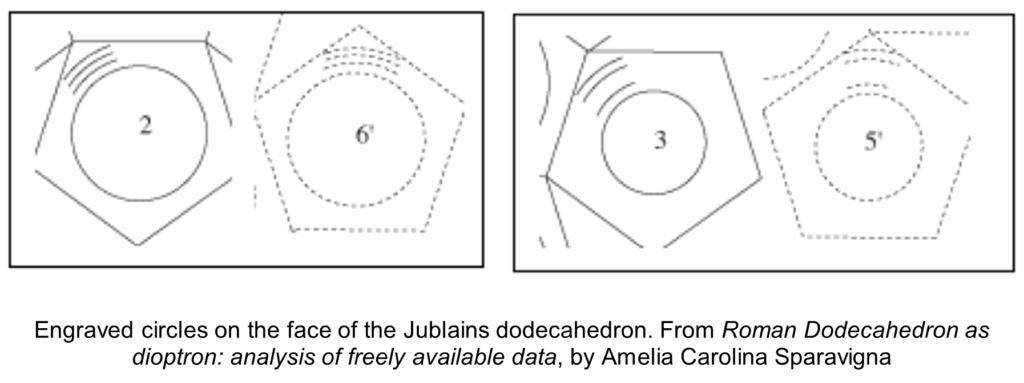
If the dodecahedrons were used as rangefinders or ancient theodolites, why weren’t they standardized in size and design? Could their variability have been related to their portability or the availability of bronze at the time and place of manufacture? Are the radii of the apertures really of practical use in range finding, and would that use hold true if all the intact dodecahedrons were similarly analyzed?
Wouldn’t we also expect this type of measuring instrument to have numerals or letters or some type of inscriptions on them, or wasn’t this necessary for those who already knew how to use them? Were the concentric circles often found around the dodecahedron apertures the only inscriptions that the users required? Although they don’t appear to have any markings that suggest their use as mathematical instruments, could it be that any original markings just haven’t survived?
Why, again, have the dodecahedrons only been discovered in the northern and northwestern regions of the Roman Empire? Wouldn’t they been widely used and found all over the Empire, as rangefinders in military situations or as rangefinders/theodolites in construction projects?
Wouldn’t a widely used instrument like this be mentioned or described or depicted in writing or drawings or in some other way, somewhere?
And again, what about the one icosahedron found? It doesn’t appear to be useful as a rangefinder or part of a theodolite, although it’s possible the icosahedron is a “red herring”, a distraction unrelated to the dodecahedrons or their use.
An Astronomical-Agricultural Device
On the website, https://www.romandodecahedron.com/, Mr. G.M.C. Wagemans provides a detailed explanation of his hypothesis on “The Roman pentagon dodecahedron an astronomic measuring instrument for determining the optimal sowing date for winter grain.”
The theory is that the Roman dodecahedrons could be used to measure the angle of sunlight passing through them. Measuring this angle, as well as knowing the latitude where the measurements are taken, would enable specific dates in springtime and autumn to be established. Those dates were particularly important for agricultural planting, with the autumn date being especially important for the planting of winter grain for the best possible production.
The summer solstice in the Northern Hemisphere occurs when the sun reaches its highest position in the sky around noon on June 21st. The Winter Solstice, when the sun reaches its lowest position in the sky, would be around noon on December 22nd. The autumnal or fall equinox is near the end of September, and it is around that time that winter grain is planted.
On a sunny autumn day, the dodecahedron would be placed on a level/horizontal surface when the sun reaches its highest point around noon. The first measurement would be the angle of the light falling through two opposing apertures determined by a trigonometric formula involving the radius of each opposing aperture and the diameter of the dodecahedron. Then, systematically these measurements would continue for all combinations of opposing apertures. The final measurement would be when sunlight passes through all the measuring points. The opposite would occur if the same measurements were taken in spring, when no sunlight would pass through any of the opposing apertures.
With the angles measured, and knowing the latitude at which the measurements are being taken, dates can be determined using astronomical formulas or established charts. To ensure that the optimum planting date or date range wasn’t missed, for example during periods of cloud, multiple measurements would be required during the target date period. According to Wagemans’ calculations, the latest dates measured for winter grain planting ranged from September 9th to October 9th, which is consistent with the autumnal equinox and the timing of modern winter grains being planted.
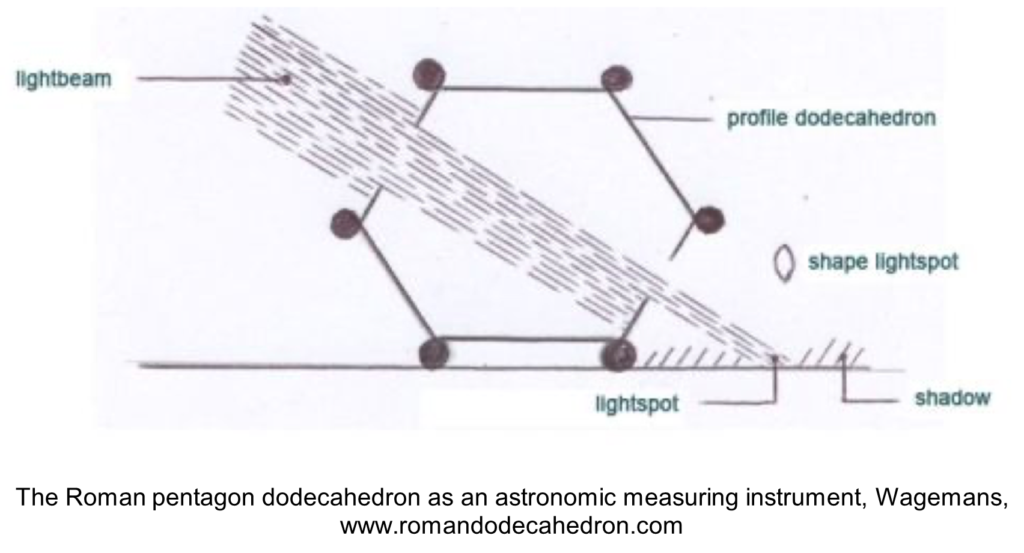
As Wagemans points out, the time for sowing winter grains is more important in the colder, harder winters of northern Europe than in the milder winter climates of the Mediterranean, making the likelihood of use and therefore discovery of dodecahedrons for this purpose greater in these areas.
He notes that the icosahedron, although it only has two opposed apertures, could also be used for this purpose. This is because the knobs, or small balls, attached to its vertices are at different diameters, allowing them to be placed in different positions. This would provide a different angle of alignment for the two opposing apertures and allow for multiple measurements of sunlight angles.
Wagemans’ research is definitely detailed and compelling, including a video demonstration of his hypothesis.
Finally, he notes that there are conditions or requirements to be met for this hypothesis to apply, and the 29 sample dodecahedrons used in his research were intended to meet these conditions. The “finding place” for each dodecahedron used must be known. Since the calculations used are dependent on the latitude of where the object was found, different latitudes would require different calculations.
For the theory to work, the dodecahedrons must to be undamaged so that the diameters of the apertures and the dodecahedrons can be accurately measured. Also, the knobs must be attached and undamaged so that the dodecahedrons sit level horizontally, and:
- The dodecahedron must have a perfectly geometrical shape.
- The centre of the dodecahedron must be exactly in the middle and the aperture perfectly round.
- The knobs must be fixed in such a way that the dodecahedron can stand horizontally in every position.
And that If one or more of these requirements has not been met, a completely different outcome will result.
And then again, there are questions.
Were the 29 dodecahedrons used actually “found” in the locations where they were originally used? It’s somewhat confusing that some reports mention only a couple of them being found in situ, while others mention a larger number, sometimes nine, found in their original location of use. It would be interesting if the most recent in situ find at Norton Disney was analyzed using this hypothesis.
Some have pointed out that the differences in aperture sizes and the overall size of the dodecahedrons mean that they can’t have been used to calculate astronomical phenomena. In other words, since all the dodecahedrons and apertures differ in diameter, they would be unsuited for astronomical calculations or measurement of any kind because result would always be different.
Overall, the hypothesis suggests that the dodecahedrons were designed and made specifically for use in northern Europe due to the harsher northern climates and not for the milder Mediterranean areas, which is why they haven’t been found there. However, many areas around the Mediterranean did and still do plant winter grains, particularly winter wheat at optimum times in fall and early winter. And then, would there have been simpler, more readily available or easier ways for farmers or Roman soldiers to determine the optimum planting times. For example, since the best time for winter grain planting is the autumnal equinox when the length of day and night are equal, couldn’t the length of day and night have been readily determined?
Would farmers or Roman soldiers have had the knowledge and experience of using mathematical formulas for sunlight angle calculation, astronomical calculations, or available charts for their particular latitude?
What To Make of All This?
So what do we know with some degree of certainty, or think we know, about the dodecahedrons?
- To date, they’ve been predominantly found in the north/northwest of what was the Roman Empire. Few of these finds are in situ, although most ex situ finds have also been in this general area;
- These areas of the Roman Empire were the frontier of interaction, both military and social, between the Romans and the Gauls/Celts;
- The dodecahedrons are all regular and were all manufactured in much the same way, other than size;
- They’re made from what appears to be Roman leaded gun metal; only one was found made of silver;
- Their walls are relatively thin;
- They were made using a wax molding technique;
- They have round knobs at all vertices;
- The knobs were attached to the vertices after molding, and all the knobs on a particular dodecahedron are the same size;
- They have a single circular aperture centred on all 12 faces. The apertures vary in size, with opposing faces having different sized apertures, and there appears to have been one found with apertures that are oval shaped;
- Intact dodecahedrons generally show little if any abrasion of the apertures;
- Many (but not every) of the dodecahedrons have geometric designs on their faces, one or more concentric circles around the apertures, lines parallel to the edges of each face, and small circles and dots;
- Some of the dodecahedrons have been found near or in burial sites, coin hoards, or near military sites and temples.
Since only one icosahedron has been found, their wider occurrence is unknown, but it appears to share some of the characteristics of the dodecahedron:
- it is a regular polyhedral shape;
- it was found in Gallo-Celtic area of the Roman Empire;
- it appears to be made of the same material and in the same way as the dodecahedrons;
- it has no letters, numbers or characters or the faces;
- there are knobs at each vertex;
- it has concentric circular patterns on the faces, consisting a group of concentric circles around a central dimple centred on each face, and three small groupings of concentric circles around a central dimple in the corners of each triangular face.
But it differs in that:
- the edges of the faces are curved slightly inward;
- the edges are decorated with many small beads of metal;
- the knobs at the vertices are of different sizes;
- there are only two apertures, one on each of two opposing faces, each with different diameters.
Which brings us to the core of the mystery.
Based on all that we know so far, or infer or guess, and looking at all of the various hypothesis and ideas and suggestions, can we come to any firm conclusion on actual purpose and use?
The short answer at this point is no.
But that doesn’t prevent us detectives from trying. And it doesn’t prevent us from looking at the possibilities, putting aside those that just don’t appear to fit the facts or inferred facts, and distilling the options down to what appear the most likely.
Everyday, Commonly Used Objects
This seems highly unlikely. If they were everyday, common items they’d expect to be found widely throughout the Roman Empire, unless there was some common purpose that was only applicable to the areas where they were found – like gloves in cold climates. But would a complicated, expensive item like this be made just for knitting gloves, and did the Romans knit? Candle holders, again, are an unlikely use, especially since they were found only in specific areas. Game pieces or toys? They’re not well suited to this use and too expensive to make, and again why would they only be in this particular area of the Empire?
Purely Decorative Objects
Again, highly unlikely due to their limited distribution, complexity and expense.
Roman Military Standard Insignia or Symbol or Decoration
Highly doubtful. They don’t seem suited to display on a standard, given their size and shape. There is no record or depiction of their use this way, no nearby remnants of standards, other insignia, emblems, or military symbols have been found, and their discovery locations don’t appear to be heavily weighted toward military origin or use. And what would they have been emblematic or symbols of?
Part of Weapon
Again, highly doubtful. Their size is too small, their weight too little, their design isn’t suitable (spikes would make sense, knobs do not), they are too fragile, and too expensive and complicated to manufacture. And why are they only found in a particular area of the Empire?
A Test of Metal Crafting Skills
They certainly would be a good test of a metal crafting skills. But why only in a particular area of the Empire?
A Calibre Standardization Tool
Highly unlikely. They range in size as do the diameters of their apertures. The apertures don’t demonstrate the wear or abrasion expected from this type of use. And why only in this part of the Empire?
A Sceptre Head
Again, highly unlikely. Their variation in size and aperture sizes don’t seem suitable. There is no evidence of any sort of secure attachment to a rod or handle, no abrasion or wear from a handle or rod, and no nearby objects that could be rods or handles. Why only in this particular area of the Empire? And if they were used as sceptre heads by the Celts, is there any evidence of this use?
So where does that leave us?
Of the ideas and hypotheses to date, three appear to have the greatest potential.
- Gallo-Celtic-Roman Mystical, Magical, Religious, Astral-Cosmic, Divination Symbols/Emblems/Talismans
Why is this compelling?
- The geographic area where the dodecahedrons have been found corresponds with the area of military and societal interaction between the Gauls/Celts and the Romans.
- Divination, sorcery and magic were widely practised in Roman times, as were the Celtic/Druid practices and traditions involving cosmic-astral and religious meaning and symbology.
- The dodecahedrons are all very consistent in design and manufacture, which would be expected of objects with common purpose, other that size which wouldn’t detract from this purpose.
- The knobs could have intentional meaning for this purpose or they could simply be for stability and handling.
- The absence of letters, numbers or characters could be because their meaning and use was already understood with no further explanation required.
- Their craftsmanship and manufacturing expense points to their being highly valued, consistent with this purpose and some of the find locations.
- Both the Romans and the Celts had the metallurgical knowledge and skills to manufacture these objects.
- A Range Finder or Part of a Surveying Device (Ancient Theodolite)
Why is this compelling?
- This offers a well-considered technological solution with practical use.
- Range-finding, surveying and angular measurements were all significantly important to Roman military and construction needs and demonstrated in their achievements for which this type of device would have been highly valued.
- The variation in size of the apertures on each face, with a smaller aperture opposite a larger aperture, suggests they could have been rotated to find the best “fit” combination of apertures for range finding.
- The lack of abrasion on the apertures fits with this type of use.
The considerable craftsmanship and expense of making the dodecahedrons would have been justified by their practical value and to ensure they were reusable, corrosion resistant and robust enough for the purpose.
- They’re highly portable and placeable with the knobs facilitating handling and stability.
However,
- Why have they only been found (so far) in the areas mentioned and not throughout the Empire?
- Wouldn’t a measuring device be expected to have letters, numbers or characters associated with their use?
- Wouldn’t they be expected to be consistent in size?
- If all the finds were analyzed, would they consistently point to this use?
- An Astronomical-Agricultural Device
Why is this compelling?
- Again, this offers a well-considered technological solution with practical use.
- Determining the optimal date for winter grain planting would have definitely been important and valuable.
- Their manufacture makes them reusable, corrosion resistant, and robust.
- The lack of abrasion on the apertures fits this type of use.
- They’re highly portable and placeable, with the knobs facilitating handling and stability.
- The area of their discovery is somewhat consistent with the greater need in norther climates.
However,
- Wouldn’t there have been simpler, more readily available, and less complicated/expensive ways of determining the autumnal equinox?
- Would the farmers and soldiers using them have had the mathematical/astrological knowledge/information required?
- Didn’t southern Europeans also need a way to determine optimum winter grain planting times?
- Wouldn’t they be expected to be consistent both design and size if they were all used for the same purpose?
- If all the finds were analyzed would they consistently point to this use?
- As a side note, if the dodecahedrons were used for some astronomical purpose could this have been associated with purpose 1 above? The Druids are known to have created myths, celebrations and practices around their astronomical knowledge.
And What About the Icosahedron?
It’s difficult to interpret, infer, or conjecture much about this singular find of unknown origin. The similarities and differences with the dodecahedrons have been noted and it’s tempting to see some kind of relationship between them. Of the three high potential purposes for the dodecahedrons, the first proposal would seem to best allow for including the icosahedron.
So Where Do We Go From Here?
For now, the mystery continues. We’ve seen some great innovative thinking, observation, analysis, and proposals. There’s been a lot of study and writing about the dodecahedrons, but still to date no definitive resolution of the question of their purpose.
To get closer and closer to the solution, if one exists, requires more detailed exploration.
- Can detailed metallurgical studies tell us more about the origins of the metals themselves, where the component materials were originally mined, and what previous metals may have been re-used?
- Can we learn more from the in situ finds, for example the recent find at Norton Disney, about their use and purpose or from other objects or materials nearby?
- Would a detailed re-examination of all the known finds yield more information about their provenance and use?
- Would thorough and completely detailed measurements of all the dodecahedrons allow a more comprehensive evaluation of their potential use as measurement devices?
- Will there be new in situ finds that will yield more information?
- Will we find recorded references in some form to the dodecahedrons?
- Will we find dodecahedrons, or references to dodecahedrons, of purely Celtic origin where no Roman interaction occurred?
As Agatha Christie had her detective, Hercule Poirot, on many cases, we now have on the “Case of the Mysterious Dodecahedrons” a self-styled “Dodecahedron Girl”, Lorena Hitchens, PhD candidate, anthropologist and archaeologist, specializing in Roman dodecahedra of Newcastle University.
Before anyone gets upset over this nickname, a note from Ms. Hitchens herself:
“Someone, who apparently did not like my topic, did not like me, or did not like the fact that it was me pursuing this topic, gave me this nickname when describing me to someone else. (Not in a complimentary way.)
Why would you call a grown woman a “girl”? There is only one reason for it – to put that “girl” in her place.
So, I decided to own the name. Literally.
The rest is history.
(Literally!)”
Please visit Lorena’s Research page.
Importantly, Lorena’s research includes far more than this article could or would attempt, including documenting “all the known finds of dodecahedra from Roman Britain (~32 of the ~130 in Europe),” and “in-depth with new laboratory analysis of three specific dodecahedra…from the eastern half of the Hadrian’s Wall corridor.” This is research that could well answer many of the questions asked here and much more.
As Ms. Hitchens writes on her site: “So, what are they, then? I’m working on it ;-)”
On that note, in a cliffhanger for all us mystery lovers, let’s say “Good Luck, Lorena” and keep us posted!

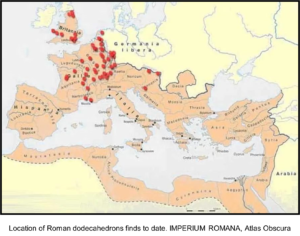
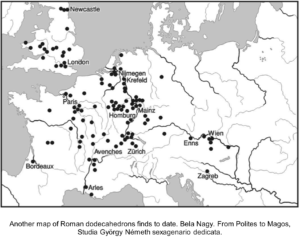
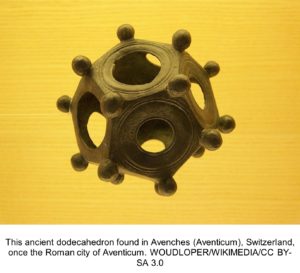
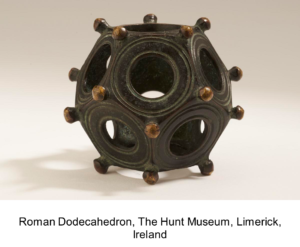
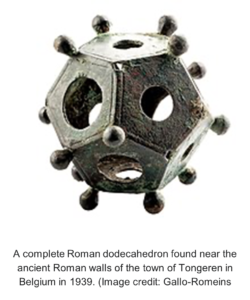
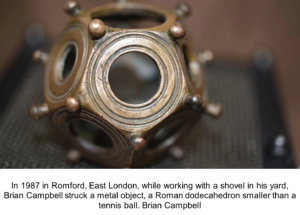
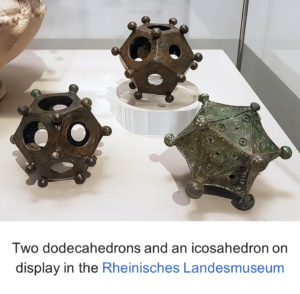
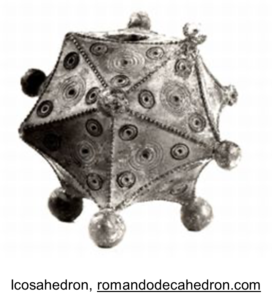
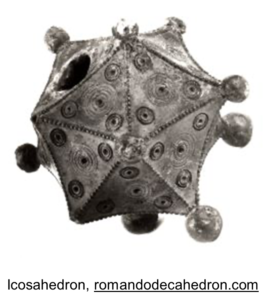

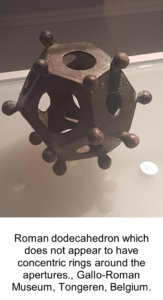
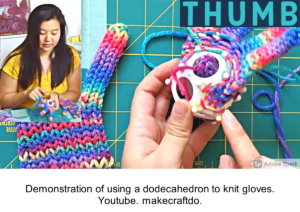

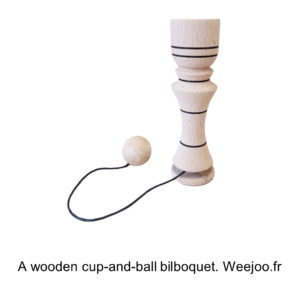
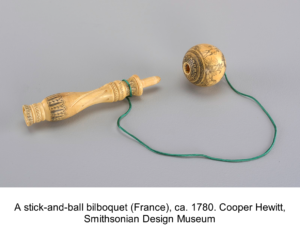
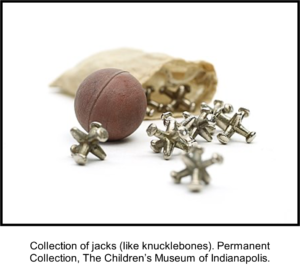
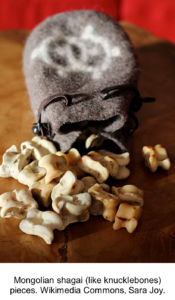
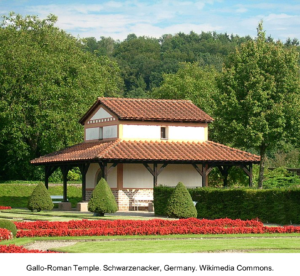
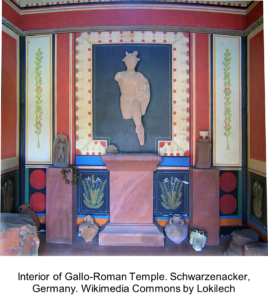
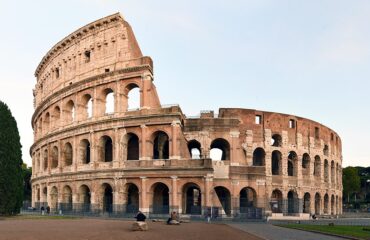


The functioning of the dodecahedron as a measuring device is based on the angle of the sun on the highest point of the day. The dates that can be measured were probably of importance for the agriculture. The sowing date of winter grain is important for the achievement of optimal produce. Therefore I anticipate that the dodecahedron would only be used in autumn time.
My hypotheses explains also the small differences in the openings of the dodecahedron of Elst, this dodecahedron is not symmetrical, and also the function of the Roman icosahedron.
Regarding the sowing date, it is also possible that with the dodecahedron and icosahedron the Celtic new year was recorded. In my opinion, this date was not November 1 but was linked to the optimal sowing date for winter grain and is therefore different in every agriculture region. See also my articles on my website about the calendar and the meaning of Halloween.
This could also explain why the function of the dodecahedrons was not described by the Romans.
Kind Regards,
Sjra Wagemans,
Thank you for your comments Sjra and for your well thought out hypothesis!
some questions:
– what additional research and analysis do you think needs to be done for your hypothesis to be confirmed?
– wouldn’t the optimal times for planting winter grains also be important in various other areas of the Roman Empire?
– are there any weaknesses you see in this hypothesis or questions that are unanswered?
I am a PhD engineer with over 30 years of experience. 3 months ago, my sister challenged me to decipher what dodecahedrons are and do. I took up the challenge, and worked it out pretty quickly. Then I ran the math (yes, there’s math involved) which confirmed my suspicion. I then ordered a replica and tested my theory, and there’s no question as to what these things do. If you have a replica and a few common items, I can prove it to you for an investment of 5 minutes of your time. After that, have fun measuring things you have around the house.
I had plans to write up my solution as a professional publication, so I wrote a 23-page essay with 17 illustrations and 28 references. But it turns out that publishing it in an archeological journal will take up to 1 year and cost me a lot of money if I make it open access. So, I’m open to letting you publish it, or a non-academic version of it, so long as I receive credit for it.
Here are a few teasers. They’re measuring instruments. They were originally painted. They measure something that no modern tool without moving parts can measure. The key to knowing how they work is knowing what it is they measure.
Can we discuss this offline? This isn’t a casual guess, and I don’t want it tossed in with the guesses. I’m contacting you about this at the suggestion of a professor of classical studies at Penn State, where I earned my PhD.
I would say these are obviously an ancient incendiary device. The hollow middle would contain a leather or animal gut bladder that would be filled with a flammable liquid. The circular holes would be optimal to support a filled bladder. The grooved rings around the holes would be smeared with wax or tar that is able to hold and be emulated to burn for more than a few seconds. The circular knobs on the edges would be to keep a space for the free flow of oxygen between other dodecahedrons when emulated; as well as, providing a small surface area to provide maximum damage through inertia when lobbed at an object. Multiple of these dodecahedrons would be loaded into a catapult like device; lit on fire and fired upon a fortification. The objects being found at random religious sites could be explained by simple human nature. After the objects being used in a siege or test, bypasses would find these objects laying around, pick them up, think they look cool and give them to their god or kept for prosperity. Round lobes will also not penetrate an adjacent bladder, preventing premature deployment and devistation to those that wielded it. And the circular grooves around the holes would be smeared with a slow burning flammable, which would ignite the bladder when it burst after the inertia of impacting an object. Those that were undamaged may have missed their mark.
This would certainly help explain why the dodecahedrons have so far been found in areas of frontier conflict!
some questions:
– wouldn’t the cost of effort and materials and skills involved in their manufacturing have made them expensive as single-use incendiary devices?
– could there possibly be any kind of residue or remnants on the surface or interior of the dodecahedrons that would indicate this use?
– would they also have been used in other areas of conflict around the Empire?
it’s a phallometer.
This guy is proposing that they were used as stands for animal horns.
Seems quite plausible!
↓↓↓
https://youtu.be/z79Lf-Hpbf4?feature=shared
Surely if it’s constructed on a complex geometric shape, it should be possible to establish angular relationships around whatever is “sighted” through the holes. Centering say, a star (or planet) through the sights, the vertices can then be used to determine angular relationships with other celestial bodies. Maybe the holes were sized differently to allow for calibration.
And it’s Celtic. If you look very carefully you can see a hidden face in the design, which was not the Roman way of doing things…
Just because these items were discovered in a particular archaeological context, doesn’t mean they originated in that time period 😉
Thanks for your comments Jim!
good point, the archaeological context where they have been found may not mean they originated in that time period or particular place, definitely something to consider when evaluating all the finds
*measuring devices are not required to be fully standardized (i.e. the opening sizes/ratios of opening pairs) if they are measuring something that varies by area
*tools don’t always show signs of wear if some of them were used strictly to measure. Some dods did not show much wear, but many did. Contrary to published work comments, many dod openings DO show signs of chips/dents, scrapes and cuts (especially some of the larger opposing openings and the largest opposing openings – damage is not just from oxidation).
Researched opinion: The Roman-Gallo dodecahedron was created for the Roman troop arms merchants (Negotiatores) & Auxiliary troop arms officers. It was used to measure, procure & maintain the Roman Auxiliary troop polearm weapon shafts; to ensure standardized specs for the varying Auxiliary troops stationed in various forts (auxiliary troops were allowed to use their own weapons which varied by troop origin). Measurement would include the diameter – mid shaft (in some instances), the taper of the shaft just outside/away from the joint at the weapon head socket (in some instances) & the taper of the wood shaft, just inside the head socket (most cases). Some were utilitized to remove the weapon heads (the largest opposing opening pair). One or more dods had triangular or oval openings (there was a weapon head with a triangular socket in use). The oval opening could be used for tool handles (Jublains’ dod).
Here’s more detailed info on my researched opinion. https://www.quora.com/What-was-the-use-of-the-Roman-dodecahedron-an-unsolved-mystery-since-1739/answer/Richard-Allday-1
thanks for your comments Richard!
and thanks for the link to your Quora article, and your link there to the 3D dodecahedron from English Heritage
couple of questions:
– would you expect this type of tool for measuring, procuring, maintaining and standardization to have been used elsewhere and widely throughout the empire?
– would it have been possible to manufacture them using less costly materials and using less complex effort and skills?
– would this mean that if multiple dodecahedrons are found in the same general area that they should all be the same size (including hole dimensions)?
Thanks for responding JB. Sorry for the late reply. I didn’t receive an email response, so I didn’t think to look back for your reply.
Here are some answers to your questions (in brackets – [ ] )
– would you expect this type of tool for measuring, procuring, maintaining and standardization to have been used elsewhere and widely throughout the empire? [No, I would not. Local arms production is the reason. In other areas of the empire, mass production was utilized. Mass production in the North and Northwest did not occur until the late 3rd century on. The dod was not needed at this point. The dod was made to order for wealthy gallic merchants and Auxiliary arms officers, based on an auxiliary troop’s specs in a certain area, by the blacksmiths supplying the pole arm weapons. Auxiliary troops (as opposed to the Legion troops) used many of their own traditional weapons which had different specs/calibers, per tribe origin. There were many different tribes in the Gallic area and they were not organized as one cohesive power; thus the differences in their weapons, & the dod opening sizes (and ratio of opposing opening sizes to each other), per dod. ]
– would it have been possible to manufacture them using less costly materials and using less complex effort and skills? [ Yes, but not in one piece and it wouldn’t last long if made of a different material. It’s kinda like a multi-tool (Swiss Army knife). It was made to order for wealthy arms merchants / auxiliary arms officers. The skill required (by a blacksmith) is not to the degree as portrayed. It’s a lost wax cast as many other casts that blacksmiths were performing daily. IOWs, If I were one of these wealthy negotiatores (merchants), I would prefer ‘one’ tool/gauge that had multiple purposes (like a Swiss army knife) made of a material that didn’t degrade (bronze), in a form that exuded affluence, & that held all the specs for a specific group that I did business with.]
– would this mean that if multiple dodecahedrons are found in the same general area that they should all be the same size (including hole dimensions)? [ No. Auxiliary troops were raised from non-cohesive tribes with differing weapon specs. These troops were moved to different garrisons / areas from time to time. Sometimes a particular dod became useless if the merchant didn’t engage didn’t travel to the new auxiliary post. A new dod would be created for a new auxiliary cohort with the 1st big order. There were many auxiliary troop groups in a regional area, also. You would see dods found in the same regional areas, but you wouldn’t see multiple dods with the exact hole dimensions/ratios. You could possible see a few that are similar but not a material #. The sizes can be more similar due to the similarity of length of the socket interior that is occupied by the wooden shaft. ]
It’s a ridiculously simple machine for projecting an angle using twine wrapped around a nib. It’s kind of beautiful and rapid in its execution. The dodecahedron has pentagonal faces which have holes used for sighting a distance determined by a ranking Roman officer. The holes need not be standardized as it was for laying out a larger or smaller military marching camp in the geometry of the Golden Rectangle as the dodecahedron contains the golden ratio and therefore projects along a sighted line held by a typical sized Roman soldier. That these encampments are found within the Gaullic and Germanic campaigns are in the approximate Golden Rectangle. That would have been a divine sacred space from the cosmological power and authority of the divine dodecahedron to offer the blessings of the gods. This was apart from the Imperial authority which was in Rome. The object itself would have been forbidden in the city of Rome as it was of a military nature and bespoke to a higher authority than Imperial. The holder of the object would have stopped the tracking soldier once he was inscribed by the circumference of the hole. The holder would then turn the dodecahedron so that the nib holding the straight line would turn to line with the navel of the holder bringing more tension and creating an angle of about 38 degrees which is part of a solution to the golden ratio based on the Pythagorean theorem. The tracking soldier would then square off of his straight line and walk until the holder of the object no longer had an angular tension and the half of the Golden Rectangle would be in place. A matter of extension then finished the project. This was done very rapidly. The interesting aspect is that the object is turned into its space in order to do this and project out in ray fashion.
A scholarly article discusses the Golden Rectangle in the military campaign areas but does not mention use of the dodecahedron, ‘The Order of Battle in the Roman Army: Evidence from Marching Camps’ by Alan Richardson. … On another note the method I describe may only approximate a Golden Rectangle or a 2/3rds ratio of the small side to the large side which is close to the inverse of the Golden Ratio of 0.6180339, and there are probably simple ways to ray project the Golden Rectangle out from the dodecahedron. A Mathematician who is familiar with polyhedra may come up with a better method.
Great comments Mark! thanks!
– has there been any experimental work done to test the use of the discovered dodecahedrons for the purpose you describe?
– does this suggest that the various sized dodecahedrons were for used for different sized encampments?
– would a tool such as this be expected to be found widely across the Roman Empire for sizing military encampments? would it have been used for other types of building layouts (non-military)?
– are there any issues or weaknesses that you’ve identified for their use in this way?
I would suspect that the various holes in any dodecahedron would be adequate for establishing different sized encampments depending on number of soldiers and equipment. As such there would be no need for exacting requirements of these spaces large or small. I’m unable to find any literature of using a dodecahedron for establishment of a structured military camp in the Golden Rectangle geometry. However, it remains that this geometry or its close approximation is documented in the planning of the encampments more so in the Gallo- Germanic and perhaps Britannic military campaign areas. As to wide use none have been found in Spain or Italy (the city of Rome for that matter). It may have been a late use as the military in the field had its authority with the commanding rank and may have wanted a way of establishing a divine or sacred order through the cosmological power and authority of the dodecahedron. So it was still a highly venerated object and thus displays as a larger spectrum of being utilitarian and an object of power and order (that the military wanted outside of Imperial Rome). So the Norton Disney Group is right in the respect that it had religious associations. But to have an expensive bronze object such as this relegated to just Cult sites for worship misses possibly a lot. The objects themselves are not generally associated with being found at Cult sites except for the latest dodecahedron which was found near a Cult site of Mars Thingsus. The dodecahedrons show redundancies which the military may have liked, so in a sense it looks over purposed for doing just one or two things. I believe the dodecahedrons found primarily in the Northern campaigns may have had more of a trade route influence but at the same time these objects would have been forbidden in the city of Rome. The dodecahedron as a geometric object is saturated with many ways a Golden section or a Golden Rectangle is present within its space. I am surprised that this has not been brought up before. That a icosahedron which is dual to the dodecahedron has been found with similar construction characteristics should be a clue as it has a saturation of Golden ratios within its space as well and could be used to the same degree. Never underestimate the superstitions of ancient Rome, even the military gambled on it.
I wrote a short article on this. Should mention that the legions also had their own armorers, metalsmiths and even in late time would have still used bronze in some cases.
https://medium.com/@markthomas058/on-a-reasonable-approach-to-the-ancient-use-of-the-roman-dodecahedron-5fd38f790bc5
The dodecahedron is a “stadiametric range finder” where range is estimated by gaging the apparent size of a distant object of approximately known size. A single hole is enough to estimate a distance by measuring the distance of the hole from the users eye when the target fills the opening. For a portable device the most practical way of measuring the eye distance is with a knotted or otherwise divided cord. The dodecahedron as range finder provided multiple holes for use with different sized targets, such as a standing man, a man on horseback, or a standardized pole. Other holes being smaller would double the useful ranges, and others would offer measurements in alternate units. Numeric markings were unnecessary because the range was determined by counting knots. The rings probably contained pigment to color code the special purpose openings and the primary pair of holes was left unmarked. All 12 holes were required to reliably cast the dodecahedron, but most likely only a few were used often.
The natural fibers available were prone to stretching in wet weather and shrinking again in dry weather, which would have affected the accuracy, and we know that the Roman surveyors used a system of pre-stretching their measuring strings around posts to prevent this. The corner posts of the dodecahedron provided a way to maintain the cord under tension so that after a long, wet march they would be ready for accurate measurement. The edge length of the dodecahedron defined the divisions of the cord, which was key to the pre-stretching system’s accurate function.
This is convenient for us because even though the cords have not survived we can still determine the measuring scales used and the height of their standard targets.
For the dodecahedrons that have reliable measurements the primary holes typically provide ranges in increments of 5, 10, 6 or 12 Roman pedes if used on 5’6″ man (1676mm) or a man on horseback (2180mm) or an unkown target of 2400mm (possibly a standard height pole).
Stadiametric range finder, (continued)
The range finding theory described so convincingly by Sparavigna, and first proposed by Kurzweil, instantly caught my attention, and I hoped it could be supported by a thorough analysis of some known examples. The dodecahedron really only makes sense as a portable, hand held device. The Romans had other methods for surveying that are well known. If the “coinciding circles” method was used exclusively then the virtual cones should always converge within arms length. But many holes pairs are of equal or nearly equal sizes and would not converge within viewing distance, let alone at arms length. Also the hole pairs that do converge would still measure only a single distance. Trying multiple holes until a match is found is impractical and suicidal in battle. Especially when a simpler method using a single hole and a measuring string was available that would measure any arbitrary distance.
The measuring string suggests a purpose for the posts. The fact that most were soldered on after casting suggests that they had an essential function beyond just making the object easier to hold.
The posts are NOT typically simple spheres, but appear optimized for cord wrapping. Typically they have a conical base that helps retain the cord, but not so extreme that the cord is pinched.
A cord wrapped around the posts at the vertices of a dodecahedron, naturally follows the (equal length) edges of the dodecahedron, dividing it into equal segments. The holes are not blocked when wound this way, and retain their function as viewing apertures.
When used the way I propose only the smaller hole of any pair matters. The larger hole is large enough so its edges don’t block the functioning smaller hole. The alignment of the hole axis with the sight line doesn’t need to be precise for an unobstructed view.
This explains why the larger hole sizes often repeat and the smaller holes never do, but instead they provide a series of sizes.
Considering this, there isn’t as many holes to choose from as it would seem. The use of color in the rings made it very easy to pick the hole.
Often the primary hole pair was distinct because of the LACK of any marking. These are typically the largest of the functioning holes, and the opposing holes are the same size or nearly the same.
And of course the string doesn’t require any marking beyond some equally spaced knots or some spots of pigment. What self-respecting guitarist would number his frets?
The Greeks in the period of Roman rule studied the geometric properties of the platonic solids. Heron of Alexandria wrote on the subject, and also on the engineering of ancient artillery and surveying. He even wrote about the procedure for pre-stretching a measuring string by winding it around posts and coating it with wax.
I think it’s likely that the Roman dodecahedron was developed by someone who was very familiar with the work of Heron of Alexandria for use as a range estimating device for artillery (ballista, etc). I imagine a brief period of popularity, being used on the frontier of the time and then falling into disuse before it could be used (and lost) in other places. A survey of places where dodecahedrons have been found, and comparison with the places where Roman armies were active in different periods, should suggest a period of use that doesn’t conflict with the limited dating information.
Thanks David for the well-reasoned comments!
and thanks as well for the references to Sparavigna and Kurzweil
the range finding hypothesis and measurement tool hypotheses in general are certainly widely proposed
– based on the purpose you describe, would the dodecahedron be expected to be found widely across the empire? including for uses other than military?
– you mention the need for thorough analysis using known examples, good point, do you know if this analysis is being done by anyone, anywhere? perhaps using replicas of original dodecahedrons?
– are there any issues or weaknesses in this potential use that you’ve identified? or questions that you’ve identified?
I’ve done what I can with the available measurements. Focusing on those with the best quality measurements, with holes sizes to the nearest half millimeter, there appears to be good correspondence to this mode of use. As I said before, they tend to measure in increments of 5, 10, 6 or 12 roman pedes with my presumed target sizes. Other holes provide these standard increments if the target was 2.4m which is a reasonable height for a vexillum (a military unit standard). But not every hole in every dodecahedron fits these starting assumptions. I would like to do a statistical study to check that these relationships aren’t just an artifact of measurement roundoff.
The military use is enough to explain the concentration of finds along the frontier. The Romans had armament workshops in these areas and they would not be expected to make them back in Italy where they weren’t needed. If a specialist workshop made these (such as in Argentomagus in Gaul) they would likely have supplied the western frontier, but not eastern frontier.
I don’t think the dodecahedron as a range finding device would be very useful in non-military applications. There were more accurate methods available when the ranged location was safely accessible.
It could easily have become a status symbol that veterans would have kept in their civilian life, but it was typical for these late empire veterans to settle in the provinces that they served in, so it shouldn’t be a surprise that not many dodecahedrons made it back to Rome.
A more likely situation would be for the object to remain in use until it was lost. If found later by the local population it would have been kept for its bronze content and possibly buried with other valuable metals.
My guess would be a counting device. It lets you calculate shares and taxes. Used to be you kept your money chest in a room with family and/or staff and expected witnesses when you opened the chest to extract or deposit money. Best place to keep your simple calculator was in the chest with the coins. The holes and markings would let a skilled user not only display his math as he did it, but in some cases feel the face and use it blind while he looked at the coins he was sorting. 12, 5, 60, 240, were all common numbers in old money. A lot of money had divisions that made it easy to tax or split shares.
If I were searching for references for this theory I would look for terms in languages other than Roman since these don’t seem to be a Mediterranean thing. Dodekaeder instead of dodecagon. But they could easily have had a different name as a calculation device.
It take a bit to explain the leather case holding a precision instrument, that used to be carried by anyone doing practical math. At one time a slide rule was immediately identified. Now explaining the quadruple log log lines to someone and how to use it would take a while. The dodecahedron might have been used in combination with coins tucked in the slots made by the raised feet. Like an abacus, it could have been used simply or an advanced user might have been able to more complex calculations with it.